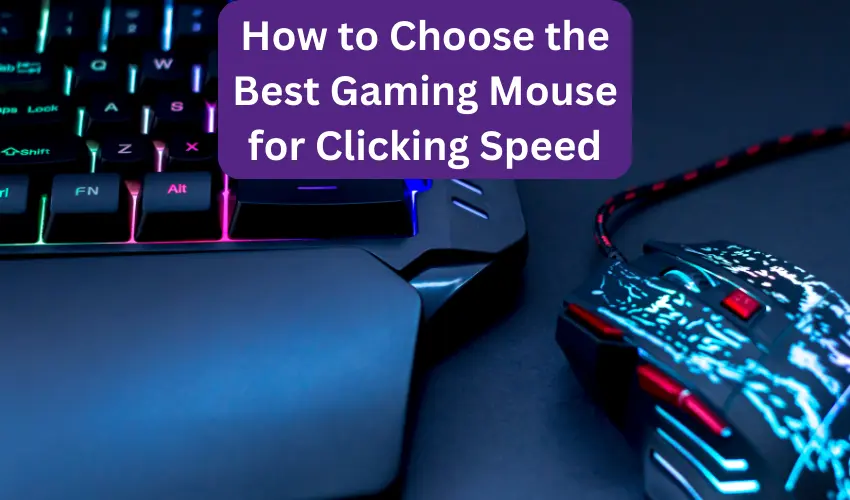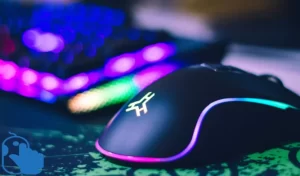When it comes to gaming, every millisecond counts. A mouse that can register clicks quickly and accurately can significantly impact your gameplay. If you want to improve your clicking speed, choosing the right gaming mouse is essential. Here’s a guide on the key features to consider before choosing the best gaming mouse for clicking speed.

1. High-Quality Switches
When it comes to gaming, the performance of your mouse can make a significant difference in your gameplay, especially when it comes to clicking speed (CPS, or clicks per second). Two main types of switches used in gaming mice are mechanical and optical switches.
Both have unique characteristics that can impact your clicking performance.
What Are Mechanical Switches?
Mechanical switches are the traditional type of switch used in many gaming mice. They consist of physical components that interact to register a click. Here are the key features:
Characteristics of Mechanical Switches:
- Tactile Feedback:
- Mechanical switches provide a tactile bump or click when pressed, giving a satisfying and responsive feel.
- Durability:
- High-quality mechanical switches are built to last, often rated for millions of clicks, ensuring long-term reliability.
- Actuation Force:
- The force required to actuate the switch can vary. Lower actuation force can result in faster and more effortless clicks.
- Customization:
- Mechanical switches come in various types (e.g., linear, tactile, clicky) that cater to different preferences and playstyles.
What Are Optical Switches?
Optical switches are a newer technology in gaming mice. Instead of physical contact, they use light to register clicks. Here are their key features:
Characteristics of Optical Switches:
- Speed:
- Optical switches can register clicks faster than mechanical switches because they use light-based actuation, eliminating the debounce delay found in mechanical switches.
- Durability:
- With fewer moving parts and no physical contact, optical switches can be even more durable than mechanical ones, often rated for an extremely high number of clicks.
- Actuation:
- Optical switches typically require less force to actuate, allowing for quicker and lighter clicks.
- Consistency:
- Optical switches offer consistent performance over time, with no degradation in click quality due to wear and tear.
Impact on Click Speed (CPS)
Mechanical Switches and CPS:
Mechanical switches offer a robust and satisfying clicking experience. The tactile feedback can help gamers feel more connected to their actions, which can enhance control and precision. However, the physical components involved can introduce a slight delay (debounce time) as the switch stabilizes after each click. This debounce time can affect maximum CPS.
Optical Switches and CPS:
Optical switches are designed for speed. The light-based actuation method removes the debounce delay, allowing for almost instantaneous click registration. This makes optical switches ideal for gamers who need to achieve high CPS. The reduced actuation force also means less effort per click, enabling faster clicking over extended periods.
Pros and Cons
Mechanical Switches:
Pros:
- Tactile feedback enhances control and satisfaction.
- Customizable switch types cater to different preferences.
- Durable with a high click lifespan.
Cons:
- Debounce delay can slightly reduce CPS.
- Physical wear can lead to inconsistent performance over time.
Optical Switches:
Pros:
- Faster actuation with no debounce delay, increasing CPS.
- Consistent performance with minimal wear.
- Highly durable with a long lifespan.
Cons:
- Lack of tactile feedback might not appeal to all gamers.
- Limited customization compared to mechanical switches.
Which Is Better for CPS?
For gamers focused on achieving the highest CPS, optical switches generally offer an edge due to their faster actuation and absence of debounce delay. They provide a consistent and reliable clicking experience that is ideal for rapid clicking scenarios.
However, mechanical switches are still a strong contender, especially for those who prefer tactile feedback and a more traditional clicking feel. The choice between mechanical and optical switches ultimately comes down to personal preference and the specific requirements of your gaming style.
Recommendation:
- For Maximum CPS: Opt for a gaming mouse with optical switches to benefit from faster response times and higher click speed.
- For Tactile Feedback and Customization: Choose a mechanical switch mouse if you value the tactile response and want more customization options.
Both types of switches have their unique strengths, so consider your priorities and gameplay needs when making your choice. Investing in a high-quality gaming mouse, regardless of switch type, will enhance your overall gaming experience and help you perform at your best.
2. DPI and Sensitivity Settings

3. Low Latency
Wired vs. Wireless
Wired mice typically have lower latency compared to wireless ones, meaning there’s less delay between your click and the action being registered on the screen. However, modern wireless mice have made significant advancements, offering low-latency performance that rivals wired options.
Polling Rate

The polling rate is how often the mouse reports its position to the computer. A higher polling rate (measured in Hz) means the mouse updates more frequently, resulting in smoother and more responsive performance. Aim for a mouse with at least a 500Hz polling rate, although 1000Hz is ideal for gaming.
Pros and Cons of Wired vs. Wireless gaming mice
Wired Gaming Mice
Pros:
- Lower Latency: Generally offer faster response times, crucial for competitive gaming.
- No Battery Concerns: Constant power supply, eliminating the need to recharge or replace batteries.
- Reliable Connection: Less prone to interference or signal loss compared to wireless mice.
- Cost-Effective: Typically cheaper than their wireless counterparts.
Cons:
- Cable Management: Cables can create clutter and restrict movement.
- Port Dependency: Requires a free USB port on your computer.
- Wear and Tear: The cable can wear out over time, potentially leading to connectivity issues.
Wireless Gaming Mice
Pros:
- Freedom of Movement: No cables to restrict your mouse movements, offering greater flexibility.
- Cleaner Setup: Reduces desk clutter, providing a cleaner and more organized workspace.
- Portability: Easier to carry around without worrying about cables.
Cons:
- Higher Latency: May experience slight lag compared to wired mice, though high-end models minimize this issue.
- Battery Life: Requires batteries or regular recharging, which can be inconvenient.
- Higher Cost: Generally more expensive than wired models.
- Potential Interference: Susceptible to wireless signal interference, which can affect performance.
4. Ergonomics and Comfort
Grip Style
Your grip style (palm, claw, or fingertip) affects the type of mouse that will be most comfortable and efficient for you. Choose a mouse that complements your grip style to reduce hand fatigue and improve clicking speed.
Weight
Lighter mice are generally easier to maneuver and can help you click faster. Many gaming mice offer adjustable weights, allowing you to find the perfect balance for your playstyle.
5. Customization Options

Programmable Buttons
Gaming mice often come with additional programmable buttons. These can be mapped to specific in-game actions, macros, or even double-click functions, enhancing your overall efficiency and speed.
Software Customization
Look for a mouse with robust software that allows you to customize DPI settings, button functions, lighting, and profiles. This level of customization can optimize the mouse for different games and tasks, ensuring peak performance.
6. Build Quality and Durability
Durability
Since gaming mice are subjected to intensive use, durability is crucial. Check for mice with high-quality materials and switches rated for millions of clicks.
Brand Reputation

Opt for well-known brands with a reputation for quality and reliability. Brands like Logitech, Razer, Corsair, and SteelSeries are popular among gamers for their high-performance products.
7. Special Features
RGB Lighting
While not directly related to performance, RGB lighting can enhance your gaming setup’s aesthetics. Many gaming mice offer customizable RGB lighting, allowing you to match it with the rest of your gear.
On-the-Fly DPI Adjustment
This feature allows you to change DPI settings quickly during gameplay, which can be particularly useful in games that require different sensitivity levels for different tasks.
Conclusion
Choosing the best gaming mouse for clicking speed involves considering a combination of features, including high-quality switches, adjustable DPI settings, low latency, ergonomic design, customization options, and durability. By focusing on these key aspects, you can find a mouse that not only enhances your clicking speed but also improves your overall gaming experience.
Investing in a good gaming mouse is a crucial step toward gaining a competitive edge in your gaming endeavors. Take the time to research and test different options to find the one that best suits your needs and playstyle.